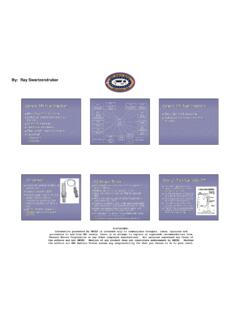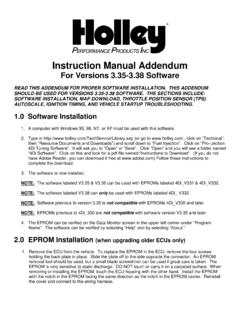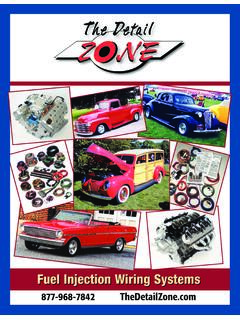Transcription of performance if you do not get the EPROM recalibrated for ...
1 This guide is designed specifically to swap a 1985-1992 GM TPI EFI system/engine into a 1970-81 Camaro. Though, for the most part, it can be used to swap in a TBI or LT1/LT4 engine/EFI system as well. All three engines install like a conventional engine on the existing motor mounts and they have the same transmission bell housing flange. The newest LS1/LS6 is a completely different animal altogether requiring extensive chassis modifications to install and will not be covered in this article. The first thing you need to take stock of is your vehicle and the system you will be installing. You need to also consider the emissions regulations in your state and how you will meet those requirements. I ll touch on the emissions system briefly, telling how to hook it up.
2 The emissions control systems are not essential to engine operation (save for maybe PCV and canister purge), but again, the emissions regulations will dictate their necessity from a legal standpoint. In California, there is a rolling 30 year exemption meaning that currently 1973 and older cars are exempt from smog. As such, I am not using EGR, AIR injection , or any of the other late model smog devices. However, I did retain my 1971 charcoal canister purge and PCV system. This article will cover two possible scenarios. The first is that you have bought an entire engine/transmission assembly or just the engine. You may or may not have the factory wiring harness and computer, you may or may not all of the sensors, injectors, and relays, or have bought new sensors to replace old or damaged ones.
3 In this scenario, you have already taken out your old engine and or transmission and installed the new one in its place. You now need to reconfigure the rest of the vehicle to run the new power plant. If you are installing an LT1, this is your only scenario since the intake manifold cannot be bolted on to an older small block without extensive modifications. However, if you re bent on doing something like that, visit the site and do a search. Several people have adapted LT1 manifolds to work the TPI. I will touch briefly on the installation of a TH700R4 and how to adapt it in to a 2nd gen since this is what I did. However, I will not discuss converting to a later model stick shift since I have no experience in that area.
4 The second scenario is that you are putting the TPI/TBI system onto an older engine. In this scenario, you have already removed the old carbureted intake manifold and bolted on the new manifold. If you have TPI, only bolt on the base plate at this point. It ll be easier to wire and plumb the system with the upper manifold and runners off (and the distributor out). Again, you now need to reconfigure the rest of the vehicle to run the system. I m kind of glossing over the TPI base plate or TBI manifold installation part because putting on an intake manifold or installing an engine is pretty generic and can be found in any repair manual. The only caveat I have for this scenario is putting TPI or TBI on a seriously modified engine- that is, one that has a camshaft over 214 intake duration, cylinder heads with 180cc or more intake ports, full length headers and free flowing exhaust systems, etc.
5 Stock TPI/TBI engines were extremely restricted as far as heads, cams, and exhaust systems go. Putting a bone stock EFI system onto a modified engine like this will result in poor, disappointing performance if you do not get the EPROM recalibrated for the new combination. This will either require you to have a professional tuning shop do it, or you can learn to do it yourself. One thing to note before you get started is that I highly recommend using the 1990-1992 system. So much so, that I m going to focus solely on installing this type of system. For reasons that will become apparent later in the guide, 1990-92 MAP systems are much more practical for EFI swaps than earlier 1985-1989 MAF ones (see sensor section for definitions of MAP and MAF).
6 If you have a 1989 or earlier MAF system, you can upgrade it to the 1990-92 configuration very easily. I ll cover that later on. Another thing is that I would HIGHLY, HIGHLY suggest is buying a good automotive scanner! I use an AutoXray. It s a very nice tool. It will read trouble codes, allow you to view real time operational data from the ECM (Electronic Control Module, aka, computer) as well as record it for future reference. You can also download this data into your PC and export it into Microsoft Excel for graphing and further analysis. This tool is invaluable for diagnosing malfunctions as well as for tuning, if you decide to get into that later. Actron also has a nice scanner, but it cannot record data. The main objective in an EFI swap is properly configuring the vehicle to work with the system.
7 This involves two areas- fuel and electrical systems. Both need to be brought up to date. We ll start with the fuel system. Vehicle fuel System Preparation TPI/LT1 engines require a constant pressure of upwards of 40 psi to run properly as well as a return line to the tank. TBI s operate on a much lower pressure of about 15 psi, but even they require a return line. In both cases, it means you will need an electric fuel pump. This presents you with two choices- either an in-tank pump or an external pump. At first glance, the external pump may appear to be the easier method, but it has several draw backs. The most obvious and complained about one is noise. Since you will be mounting the pump to the chassis, the humming of the pump will be transmitted through the frame and will be audible inside the vehicle.
8 While only a mild annoyance, it takes away from the factory-ness of the swap. The second drawback is the heat generation. Cooling is mainly by convection (whereas an in-tank pump is submerged in a cooling medium, the fuel ). Since there ll be a lot of rubber (thermally insulating) padding to keep the pump mechanically isolated from the frame (to reduce vibration noise transmission) the heat conduction away from the pump is significantly reduced. Therefore, overheating the pump is a possibility. The third problem is fuel starvation. Unless internal baffling is added to the tank, low fuel levels combined with hard braking/acceleration and/or hard cornering can uncover the fuel pickup allowing the pump to suck air. Electric fuel pumps do not like to suck air since it reduces the life of the pump significantly.
9 In my opinion, the best way to install an electric pump is to go in-tank. It s a lot easier than you may think and you eliminate all of the above problems. The key to the installation is to find a V8 or V6 late-third generation fuel tank sender like the one shown below. NOTE: It was recently discovered that a third gen sender does not fit into late second generation Camaro s. It s unknown the exact cut-off year. However, if cannot verify if the opening for your sender is not the same as a 1970-73, then this sender will not work with your fuel tank. As you can see it has everything on it that you need and it s a factory setup! Now, the beauty of this is that it will fit into a second generation fuel tank with minimal modifications.
10 Namely: 1.) The depth of the fuel tanks between 2nd and 3rd gen tanks vary with the model year. As such, minor bending of the lines leading into the tank will probably be necessary. This can be accomplished by hand (but be gentle and don t kink the lines!). Basically, measure the depth of your tank from the top flange of the sending unit to the bottom of the tank and make sure that the pump assembly is no more than 1/4 from the bottom. 2.) The fuel level electrical sender will operate the factory 2nd gen fuel gauge perfectly (don t you just love GM?). Both operate on a 0-90 ohm potentiometer operated by a float arm. However again, due to depth variations between tanks, you may need to do some minor bending on the float arm such that it is calibrated to the dimensions of your fuel tank.





